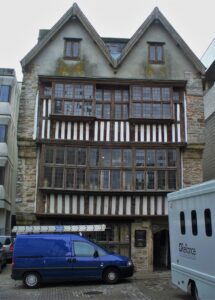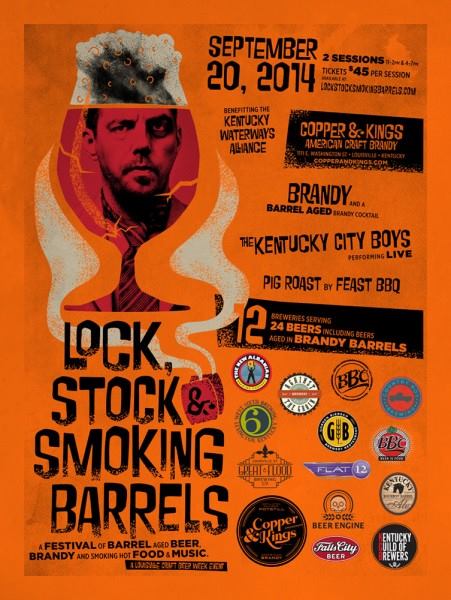
The best part of beer traveling is all the other things one learns while in pursuit of beer.
The Merchant’s House museum in Plymouth U.K. is one of the few remaining Elizabethan (1558-1603) buildings in a city where the urban core was very nearly wiped clean by the Luftwaffe during World War II, destruction suffered as collateral damage when the Germans targeted the Royal Navy’s base of operations in Plymouth, one of England’s finest natural ports.
I’m informed by the interwebz that the house is closed to the public at the present time, with a restoration project supposedly waiting in the wings (the Plymouth Herald seems very skeptical) but in 2009 the historic building was still welcoming tourists like us. I took only two photos on the day of our visit, one of the exterior and the other of a dog and pot.
It’s taken a mere 14 years for me to seek an answer to the question that likely came to mind back in 2009: “Why a dog and pot?” Procrastination is a lifelong specialty of mine, but here we go, at last.
As you might guess, the Dog and Pot originally was the name of a pub in Plymouth. I’ve highlighted a passage from Wikipedia’s explanation of pub names and signs.
Pub names are used to identify and differentiate traditional drinking establishments. Many pubs are centuries old, and were named at a time when most of their customers were illiterate, but could recognise pub signs. The use of signage was not confined to drinking establishments. British pubs may be named after and depict anything from everyday (particularly agricultural) objects, to sovereigns, aristocrats and landowners (shown by their coats of arms). Other names come from historic events, livery companies, occupations, sports, and craftsmen’s guilds.
Specifically, Plymouth’s Dog and Pot was a 19th-century watering hole favored by seamen, given its location near the ships at the dockyards gate in Devonport.
But what does it mean?
Seemingly a reference to an old joke about a lazy wife who let her dog lick her pots clean and then used its tail to dry them (there is a similarly named alehouse in Stoke Poges), the visual depiction of a dog and pot is also used by iron mongers, indicating that they sold iron dogs for coal scuttles.
This reference to iron mongers is revealing in two ways. It tells us that objects and signs deployed to assist recognition in olden times of widespread illiteracy were not restricted to pubs, and moreover, that these images weren’t always what they might seem at first glance — a fact famously noted two centuries ago by youthful journalist Charles Dickens with regard to a Dog and Pot in London.
“My usual way home was over Blackfriars Bridge, and down that turning in the Blackfriars Road which has Rowland Hill’s chapel on one side, and the likeness of a golden dog licking a golden pot over a shop door on the other.”
Thus, the source of “dog and pot’s” two meanings.
The original configuration of canine and kitchen apparatus belonged to a 16th-century pub. It was eventually appropriated in the late 1700s by an ironmongers business. The image of a dog and bowl is a visual pun. The term “dog” is used to describe iron bars that support pots in the process of smelting, thus giving us an image of a dog and pot.
Whether sailors or iron workers, it’s easy to imagine thirsty habitués of the Dog and Pot, whether in Plymouth or London, draining tankards of Mild, a topic examined previously (and lovingly) in this space.
I’ll resist the raging temptation to flatter my habit of drawing myriad cross-cultural conclusions, and instead offer a polite and entirely predictable observation that clever pub names, cask-conditioned Mild and even the slightest hint of pie and mash availability combine to induce an Anglo-fueled reverie amid what passes for a soul in me.
Edibles & Potables: How do you make change for an eel (pie)?
The fact that the Endeavour television series has come to an end, and I’m inconsolable, suggests more than one pint of Mild might be needed—but I digress, and this edition of “Hips Hops” concludes with links for further reading about beer.
—
At The Bulletin, we learn about environmentally friendly barley: Brussels Beer Project launches new environmentally friendly beer.
“The new beer is made entirely with barley from regenerative agriculture, a term that refers to farming practices which take into account, among other things, biodiversity and soil quality when cultivating the land.”
But as the great Kate Bernot reminds us at Good Beer Hunting, craft malting is just as reliant on the vagaries of mammon as any other business endeavor: At What Cost — Abrupt Skagit Valley Malt Closure Highlights Risks of Craft Malt Expansion.
“The unexpected closure and forthcoming bankruptcy of Washington State’s Skagit Valley Malt has left employees, breweries, distilleries, and barley farmers reeling, with financial and business ramifications impacting them all.”
Conversely, the craft beer enthusiast might opt for a full-scale immersion via the Wayback Machine, do away with barley altogether, and recall the gentle tickle of “corn in the morn” (at Porch Drinking): Chicha, the original beer of South America.
“Because corn is native to the Americas, it was only natural that Indigenous peoples used it as the base grain for their version of beer. Aside from the base, Chicha production is similar to barley-based brews. The corn is germinated, dried, milled and boiled into a wort before being traditionally fermented in clay jars. Modern producers are more likely to use steel tanks, however, as clay jars are much less durable.”
While we’re on this topic of Chicha, let’s indulge a brief debunking.
“To this day the myth persists that all Chicha is made by chewing corn kernels and fermenting the resulting spit/corn mixture. This is almost entirely untrue.”
That’s too bad, because it would lend a whole new dimension to the notion of “mouth feel.”
Speaking of rural and indigenous implications, WLKY-32 has a report about the opening of Country Boy Brewing’s new taproom, nestled smack dab in the heart of Kentucky’s largest city, and presumably right next to the cement pond: Check out Country Boy Brewing, now open inside Louisville’s Omni Hotel.
“Country Boy Brewing opened a taproom inside the Falls City Market in downtown Louisville, which is inside the Omni Hotel. They held an opening party on Thursday. There are 24 beers on tap, like their popular Cougar Bait and Shotgun Wedding, and they also have a food menu of pizza, sandwiches and more.”
In closing this edition of “Hip Hops,” one of the greatest unanswered questions in the entirety of the global brewing business is why AB InBev doesn’t simply hire the Wagner Group’s currently under-employed mercenaries to further its war for worldwide market share, considering the monopolistic monolith’s traditional (and ongoing) absence of discernible standards of taste and decency.
Yevgeny Prigozhin of Wagner and AB InBev’s Michel Doukeris (as opposed to Massachusetts’ Michael Dukakis) strike me as two peas in a pod, although there’ll be the occasional reader who is surprised to learn that the global conflict between AB InBev and everyone else didn’t begin yesterday:
• A quarter century ago (All About Beer): Pacific Ridge was Bud’s answer to Sierra Nevada Pale Ale.
“There has long been a battle between the large breweries of the world and the smaller craft entities. At stake is millions of dollars and what Anheuser-Busch has called ‘share of throat.’”
• In the present day (Beervana): There are two Kona breweries, and one is independent.
“The US Department of Justice decided that the deal would create too much consolidation in Hawaii, and demanded that ABI spin off the Kona brewery before they’d approve the CBA acquisition. ABI complied, and the result is a very weird situation in which there are two separate businesses selling the same beer.”
Happy reading, and remember that the best part of beer knowledge is being able to tell the difference between one’s friends and enemies.



















 Roger Baylor is an entrepreneur, educator, and innovator with 41 years of beer business experience in metropolitan Louisville as a bartender, package store clerk, brewery owner, restaurateur, writer, traveler, polemicist, homebrewing club founder, tour operator and all-purpose contrarian.
Roger Baylor is an entrepreneur, educator, and innovator with 41 years of beer business experience in metropolitan Louisville as a bartender, package store clerk, brewery owner, restaurateur, writer, traveler, polemicist, homebrewing club founder, tour operator and all-purpose contrarian.
